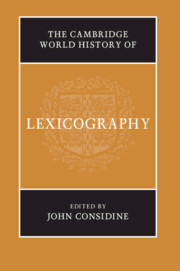Book contents
- The Cambridge World History of Lexicography
- The Cambridge World History of Lexicography
- Copyright page
- Contents
- Contributors
- Editor’s Acknowledgements
- Introduction
- Part I The Ancient World
- Part II The Pre-Modern World
- 6 China, c. 600–c. 1700
- 7 India and Tibet, c. 500–c. 1750
- 8 Arabic to c. 1800
- 9 Hebrew to c. 1650
- 10 The Chinese Periphery to c. 1800
- 11 The Turkic Languages and Persian to c. 1700
- 12 Byzantine Greek
- 13 Medieval Latin Christendom
- 14 Early Modern Western and Central Europe
- Part III The Modern World: Continuing Traditions
- Part IV The Modern World: Missionary and Subsequent Traditions
- Appendix 1 The Language Varieties
- Appendix 2 The Lexicographers
- Primary Sources
- Secondary Sources
- Index
7 - India and Tibet, c. 500–c. 1750
from Part II - The Pre-Modern World
Published online by Cambridge University Press: 01 September 2019
- The Cambridge World History of Lexicography
- The Cambridge World History of Lexicography
- Copyright page
- Contents
- Contributors
- Editor’s Acknowledgements
- Introduction
- Part I The Ancient World
- Part II The Pre-Modern World
- 6 China, c. 600–c. 1700
- 7 India and Tibet, c. 500–c. 1750
- 8 Arabic to c. 1800
- 9 Hebrew to c. 1650
- 10 The Chinese Periphery to c. 1800
- 11 The Turkic Languages and Persian to c. 1700
- 12 Byzantine Greek
- 13 Medieval Latin Christendom
- 14 Early Modern Western and Central Europe
- Part III The Modern World: Continuing Traditions
- Part IV The Modern World: Missionary and Subsequent Traditions
- Appendix 1 The Language Varieties
- Appendix 2 The Lexicographers
- Primary Sources
- Secondary Sources
- Index
Summary
This chapter tells part of the story of lexicography in India and Tibet: that is, the geographical areas influenced by the Indian and Tibetan cultures. In other words, this is the story of the lexicography of the Sanskrit, Pali, Prakrit, and Tibetan languages. The time of the story to be told here is between the fifth and the seventeenth centuries. The story before the fifth century is narrated in , and the one after the seventeenth century in Chapters 18 and 30.
Although Sanskrit has been a predominant language in academic circles from ancient times to the present, Pali and various Prakrits also have an important place in Indian literature. These three languages are chiefly associated with three major Indian religions: Brahmanism, Buddhism, and Jainism.
- Type
- Chapter
- Information
- The Cambridge World History of Lexicography , pp. 130 - 158Publisher: Cambridge University PressPrint publication year: 2019

